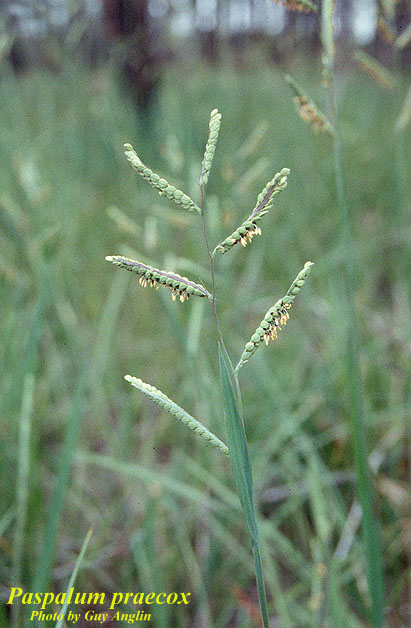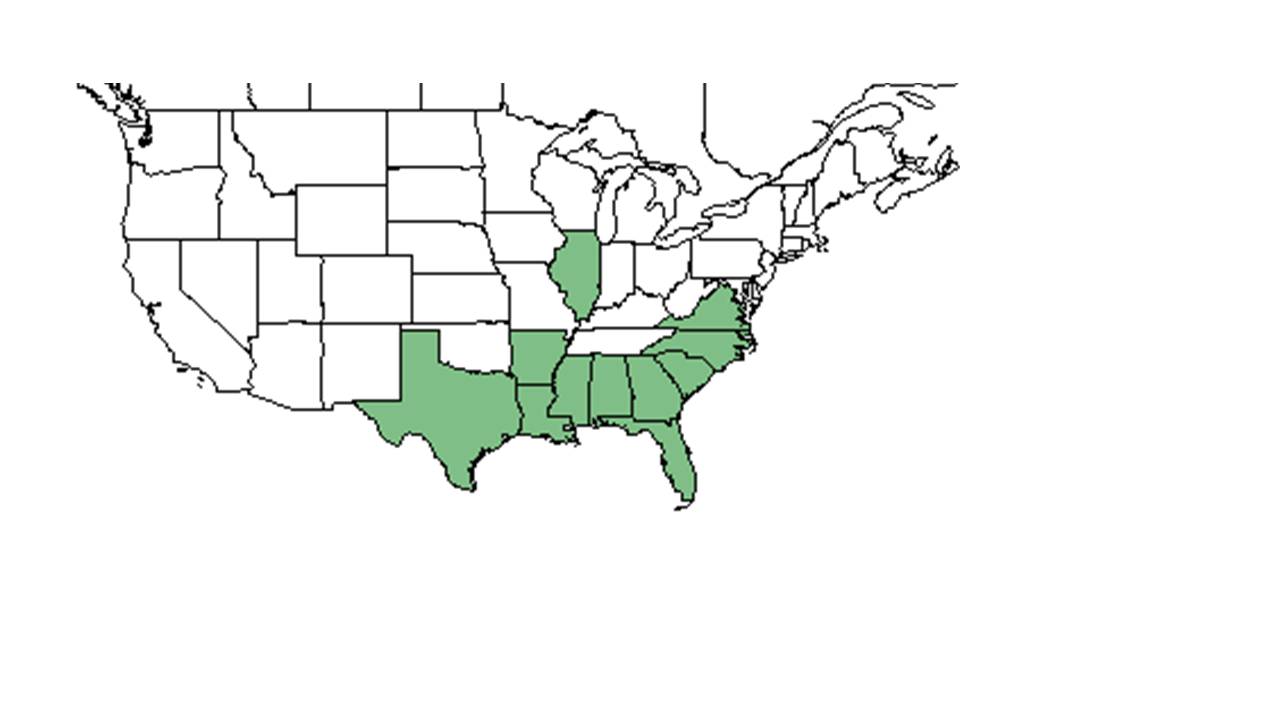Difference between revisions of "Paspalum praecox"
(→Conservation and Management) |
Krobertson (talk | contribs) |
||
| Line 24: | Line 24: | ||
==Description== | ==Description== | ||
<!-- Basic life history facts such as annual/perrenial, monoecious/dioecious, root morphology, seed type, etc. --> | <!-- Basic life history facts such as annual/perrenial, monoecious/dioecious, root morphology, seed type, etc. --> | ||
| − | "Annuals or perennials. Leaves primarily basal and low cauline; blade margins usually scaberulous; ligules membranous. Spikelets plano-convex, terminal floret fertile, basal floret sterile. Frist glume usually absent, sterile lemma resembles 2nd glume; fertile lemma and paleas indurate, lustrous, yellowish or brownish. These plants are all important forage grasses." | + | "Annuals or perennials. Leaves primarily basal and low cauline; blade margins usually scaberulous; ligules membranous. Spikelets plano-convex, terminal floret fertile, basal floret sterile. Frist glume usually absent, sterile lemma resembles 2nd glume; fertile lemma and paleas indurate, lustrous, yellowish or brownish. These plants are all important forage grasses." </ref name="Radford et al 1964">Radford, Albert E., Harry E. Ahles, and C. Ritchie Bell. Manual of the Vascular Flora of the Carolinas. 1964, 1968. The University of North Carolina Press. 136. Print.</ref> |
| − | "Erect perennial from short rhizomes; culms 6-9 dm tall, nodes and internodes glabrous. Blades to 20 cm long, 1.5-4 mm wide, glabrous or villous on both surfaces, occasionally pilose basally above; sheaths glabrous, villous or sparsely papillose above, margins smooth; ligules 2-2.5 mm long. Racemes 3-5, racemose, ascending, 2-6 cm long; rachis wing scaberulous, 1-1.2 mm wide. Spikelets broadly obovoid to suborbicular, flattish, 2.2-3.2 mm long, in 4 rows, 2 rows rudimentary; pedicels scaberulous angled, 0.1-1 mm long. Second glume and sterile lemmas 3-nerved, yellowish green , margins scarious, obtuse 2.2-3.2 mm long; fertile lemma and palea nerveless, papillose, obtuse, 2.2-3.2 mm long. Grain brownish, broadly ellipsoid, flat, 2 mm long." | + | "Erect perennial from short rhizomes; culms 6-9 dm tall, nodes and internodes glabrous. Blades to 20 cm long, 1.5-4 mm wide, glabrous or villous on both surfaces, occasionally pilose basally above; sheaths glabrous, villous or sparsely papillose above, margins smooth; ligules 2-2.5 mm long. Racemes 3-5, racemose, ascending, 2-6 cm long; rachis wing scaberulous, 1-1.2 mm wide. Spikelets broadly obovoid to suborbicular, flattish, 2.2-3.2 mm long, in 4 rows, 2 rows rudimentary; pedicels scaberulous angled, 0.1-1 mm long. Second glume and sterile lemmas 3-nerved, yellowish green , margins scarious, obtuse 2.2-3.2 mm long; fertile lemma and palea nerveless, papillose, obtuse, 2.2-3.2 mm long. Grain brownish, broadly ellipsoid, flat, 2 mm long." <ref name="Radford et al 1964"/> |
==Distribution== | ==Distribution== | ||
| Line 32: | Line 32: | ||
===Habitat=== <!--Natural communities, human disturbed habitats, topography, hydrology, soils, light, fire regime requirements for removal of competition, etc.--> | ===Habitat=== <!--Natural communities, human disturbed habitats, topography, hydrology, soils, light, fire regime requirements for removal of competition, etc.--> | ||
| − | This species has been found growing in open areas of longleaf and slash pine in wet, sandy and peaty soils | + | This species has been found growing in open areas of longleaf and slash pine in wet, sandy and peaty soils. <ref name="FSU Herbarium">Florida State University Robert K. Godfrey Herbarium database. URL: [http://herbarium.bio.fsu.edu http://herbarium.bio.fsu.edu]. Last accessed: June 2014. Collectors: Loran C. Anderson, Wilson Baker, Ann F. Johnson, Robert K. Godfrey, R. Komarek, Travis MacClendon, and Karen MacClendon. States and Counties: Florida: Calhoun, Dixie, Liberty, and Wakulla. Georgia: Thomas.</ref> It has also been found in moist, loose, and loamy sands of ditches along trails within pine plantations. <ref name="FSU Herbarium"/> Associated species include ''Andropogon, Sorghastrum,'' and ''Pinus palustris.'' <ref name="FSU Herbarium"/> |
===Phenology=== <!--Timing off flowering, fruiting, seed dispersal, and environmental triggers. Cite PanFlora website if appropriate: http://www.gilnelson.com/PanFlora/ --> | ===Phenology=== <!--Timing off flowering, fruiting, seed dispersal, and environmental triggers. Cite PanFlora website if appropriate: http://www.gilnelson.com/PanFlora/ --> | ||
| − | This species has been observed flowering in July and fruiting in October | + | This species has been observed flowering in July and fruiting in October. <ref name="FSU Herbarium"/> |
<!--===Seed dispersal===--> | <!--===Seed dispersal===--> | ||
<!--===Seed bank and germination===--> | <!--===Seed bank and germination===--> | ||
===Fire ecology=== <!--Fire tolerance, fire dependence, adaptive fire responses--> | ===Fire ecology=== <!--Fire tolerance, fire dependence, adaptive fire responses--> | ||
| − | This species can be found in burned, open longleaf pine areas | + | This species can be found in burned, open longleaf pine areas. <ref name="FSU Herbarium"/> |
<!--===Pollination===--> | <!--===Pollination===--> | ||
<!--===Use by animals===--> <!--Herbivory, granivory, insect hosting, etc.--> | <!--===Use by animals===--> <!--Herbivory, granivory, insect hosting, etc.--> | ||
| Line 51: | Line 51: | ||
==References and notes== | ==References and notes== | ||
| − | |||
| − | |||
| − | |||
Revision as of 19:17, 4 August 2016
| Paspalum praecox | |
|---|---|

| |
| Photo by Guy Anglin, Atlas of Florida Vascular Plants | |
| Scientific classification | |
| Kingdom: | Plantae |
| Division: | Magnoliophyta - Flowering plants |
| Class: | Liliopsida – Monocotyledons |
| Order: | Cyperales |
| Family: | Poaceae ⁄ Gramineae |
| Genus: | Paspalum |
| Species: | P. praecox |
| Binomial name | |
| Paspalum praecox Walter | |

| |
| Natural range of Paspalum praecox from USDA NRCS Plants Database. | |
Common name: Early paspalum
Contents
Taxonomic notes
Synonyms: Paspalum praecox Walter var. curtisianum (Steudel) Vasey; P. lentiferum Lamarck
Description
"Annuals or perennials. Leaves primarily basal and low cauline; blade margins usually scaberulous; ligules membranous. Spikelets plano-convex, terminal floret fertile, basal floret sterile. Frist glume usually absent, sterile lemma resembles 2nd glume; fertile lemma and paleas indurate, lustrous, yellowish or brownish. These plants are all important forage grasses." </ref name="Radford et al 1964">Radford, Albert E., Harry E. Ahles, and C. Ritchie Bell. Manual of the Vascular Flora of the Carolinas. 1964, 1968. The University of North Carolina Press. 136. Print.</ref>
"Erect perennial from short rhizomes; culms 6-9 dm tall, nodes and internodes glabrous. Blades to 20 cm long, 1.5-4 mm wide, glabrous or villous on both surfaces, occasionally pilose basally above; sheaths glabrous, villous or sparsely papillose above, margins smooth; ligules 2-2.5 mm long. Racemes 3-5, racemose, ascending, 2-6 cm long; rachis wing scaberulous, 1-1.2 mm wide. Spikelets broadly obovoid to suborbicular, flattish, 2.2-3.2 mm long, in 4 rows, 2 rows rudimentary; pedicels scaberulous angled, 0.1-1 mm long. Second glume and sterile lemmas 3-nerved, yellowish green , margins scarious, obtuse 2.2-3.2 mm long; fertile lemma and palea nerveless, papillose, obtuse, 2.2-3.2 mm long. Grain brownish, broadly ellipsoid, flat, 2 mm long." [1]
Distribution
Ecology
Habitat
This species has been found growing in open areas of longleaf and slash pine in wet, sandy and peaty soils. [2] It has also been found in moist, loose, and loamy sands of ditches along trails within pine plantations. [2] Associated species include Andropogon, Sorghastrum, and Pinus palustris. [2]
Phenology
This species has been observed flowering in July and fruiting in October. [2]
Fire ecology
This species can be found in burned, open longleaf pine areas. [2]
Conservation and management
Cultivation and restoration
Photo Gallery
References and notes
- ↑ Cite error: Invalid
<ref>tag; no text was provided for refs namedRadford et al 1964 - ↑ 2.0 2.1 2.2 2.3 2.4 Florida State University Robert K. Godfrey Herbarium database. URL: http://herbarium.bio.fsu.edu. Last accessed: June 2014. Collectors: Loran C. Anderson, Wilson Baker, Ann F. Johnson, Robert K. Godfrey, R. Komarek, Travis MacClendon, and Karen MacClendon. States and Counties: Florida: Calhoun, Dixie, Liberty, and Wakulla. Georgia: Thomas.